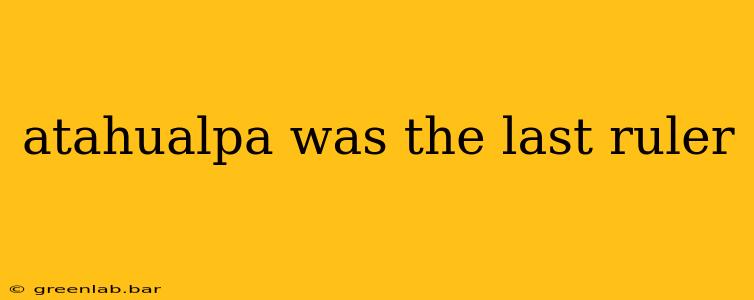Atahualpa's name echoes through history as the last Sapa Inca, the ruler of the vast and powerful Inca Empire before its conquest by the Spanish. His reign, though tragically short, was marked by internal strife, ambitious plans, and ultimately, a dramatic end that forever altered the course of South American history. This exploration delves into the life and legacy of Atahualpa, examining the circumstances surrounding his rise to power, his confrontation with Francisco Pizarro, and the lasting impact of his demise.
The Road to Power: Civil War and Succession
Atahualpa's ascension to the Inca throne was far from peaceful. Following the death of Huayna Capac, the previous emperor, a brutal civil war erupted between Atahualpa and his half-brother Huáscar. This conflict, fueled by competing claims to the throne and differing visions for the empire, fractured the Inca state and weakened its defenses against the impending Spanish invasion. Atahualpa, initially the governor of Quito, skillfully manipulated alliances and utilized superior military tactics, ultimately defeating Huáscar and seizing control of Cusco, the Inca capital. This internal struggle significantly depleted the empire's resources and manpower, creating a vulnerability that Pizarro would ruthlessly exploit.
Atahualpa's Reign: A Brief Interlude of Power
Atahualpa's reign as Sapa Inca was brief, lasting only a few years. Nevertheless, accounts suggest he was a capable administrator and a shrewd political strategist. He implemented reforms, consolidated his power, and continued many of his father's policies. However, the shadow of the civil war loomed large, and the empire remained unstable. It was during this period of fragile peace that the Spanish conquistadors arrived on the shores of Peru, unwittingly setting the stage for a dramatic and irreversible shift in Inca history.
The Capture at Cajamarca: A Turning Point in History
The infamous encounter at Cajamarca in 1532 remains one of the most pivotal moments in the conquest of the Inca Empire. Atahualpa, unaware of the Spanish weaponry and tactics, accepted an invitation to meet with Francisco Pizarro under a deceptive guise of peace. This meeting, however, turned into a massacre. The Spanish, utilizing superior firepower and employing a surprise attack, captured Atahualpa, effectively crippling the Inca's ability to resist.
The Ransom and the Execution: A Tragic End
Following his capture, Atahualpa offered an enormous ransom in gold and silver in exchange for his freedom. While the Inca diligently collected the promised wealth, Pizarro ultimately reneged on the agreement, finding various pretexts to execute Atahualpa. The execution, carried out by strangulation, marked the definitive end of Inca independence and signaled the beginning of the Spanish colonial era in Peru. The vast riches amassed through the ransom further fueled the Spanish conquest and profoundly impacted the Inca Empire's trajectory.
The Legacy of Atahualpa: Beyond the Conquest
Despite the brevity of his reign and his tragic demise, Atahualpa's legacy extends far beyond the immediate consequences of the Spanish conquest. He remains a symbol of resistance, a figurehead representing the resilience and strength of the Inca civilization. His story serves as a powerful reminder of the devastating impact of colonialism and the complexities of power dynamics in pre-Columbian America. The study of his life continues to provide valuable insights into the intricacies of Inca society, politics, and culture, reminding us of the rich history that was forever altered by the arrival of the Spanish. His tale is a crucial element in understanding the broader context of the Inca Empire's fall and the lasting influence of this historical event on the Americas.

